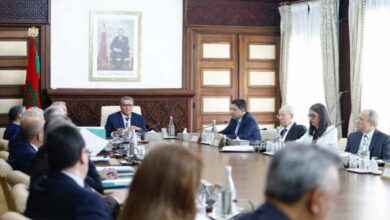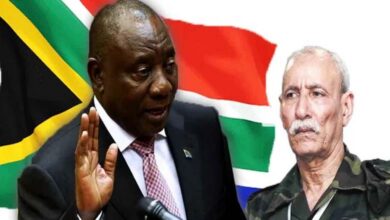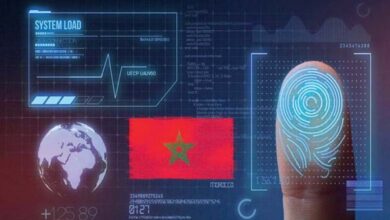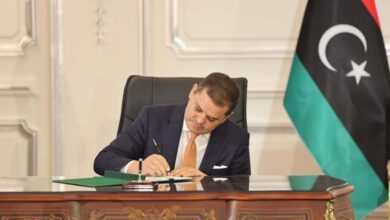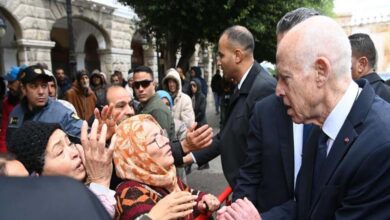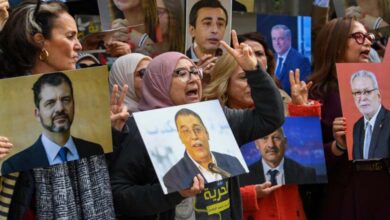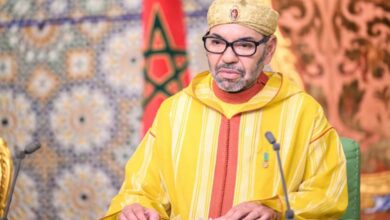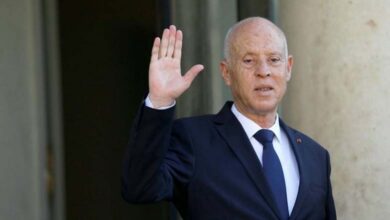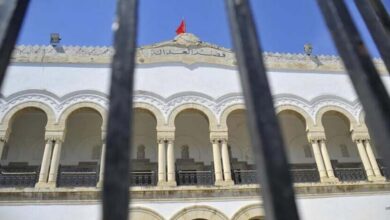The Tunisian Muslim Brotherhood and the Assassination of Belaïd… A Fragmented Narrative

Being both the storyteller and the culprit inevitably leads to an incomplete narrative—especially when you hold all the threads of the conspiracy and its execution.
This sums up the story of the assassination of Chokri Belaïd, a fierce Tunisian opposition figure whose voice was silenced by a hail of bullets while he sat in his car, preparing to leave his home in a northern suburb of the capital.
-
Pursued with Incitement Charges Against Belaïd… What Do You Know About Tunisian Brotherhood Figure Habib Ellouze?
-
Eight years since the assassination of “Belaid”… A memory surrounding the Tunisian Fraternity
The assassination took place on February 6, 2013, when the Muslim Brotherhood controlled the government, with Ali Larayedh as Minister of the Interior—a “puppet master” who used his position to shield the organization.
Belaïd was struck down by extremist bullets, and his death sent shockwaves through the Muslim Brotherhood, triggering mass protests in the streets of the capital. Crowds chanted, “Down with the Muslim Brotherhood regime” and “Down with Belaïd’s killers.”
-
Tunisian Brotherhood: Conspiracies to “Reposition” Before Presidential Elections
-
Tunisia and the Assassination of Brahmi: A “Brotherhood Trick” Causes Case Delay
A Fragmented Narrative
The Brotherhood attempted to present a fragmented version of events, aided by their control over the state’s institutions and agencies. Yet, despite their efforts, evidence and testimonies continued to emerge, holding them politically—if not criminally—responsible.
That night, an unexpected power outage occurred in the El Menzah VI district, where Belaid resided in an apartment building along the main road.
The cause of the blackout remains unknown to this day, but the most plausible theory is that those planning Belaid’s assassination orchestrated it to ensure the area surrounding his building was free of cameras or obstacles, allowing them to map out the execution point and escape route.
-
“The Secret Apparatus” of Tunisia’s Brotherhood: A “Black Box” from Darkness to Light
-
Tunisia in 2025… Year of « Security Vigilance » and Resolution against the Muslim Brotherhood
The events of the following day provided a series of clues—many of which remain unverified, pending the completion of the trial of those accused in the case.
According to a journalist who lived on the fourth floor of the same building as Belaid, whose apartment was on the first floor, she witnessed his driver waiting in the car outside.
The scene appeared entirely routine—nothing out of the ordinary. The same ritual played out every morning. However, what transpired in the next few minutes was unprecedented—not just for that neighborhood but for all of Tunisia.
-
Defense Committee for Belaid and Brahmi is in favor of the surrender of Kaïs Saïed to the prosecution
-
Judgments Issued in Belaid Case After 11 Years of His Assassination
Journalist Nadia Daoud reported seeing a man approach Belaid’s driver, exchange a few words, and then quickly walk away. Shortly after, Belaid exited his building and headed toward the car.
Suddenly, a motorcycle carrying two men approached just as Belaid was settling into the passenger seat. One man remained on the bike while the other jumped off, firing a single shot at first, followed by three successive bullets.
Accounts differ on this detail—some claim the first shot was meant to shatter the car window, while the remaining bullets tore through Belaid’s body, turning the black seat crimson with blood.
-
The Tunisian Brotherhood Anticipates Conspiracies Against the Country and Launches a New Maneuver… What Is It?
-
Terrorism besieges the Ennahdha Movement in Tunisia… Detention warrant for the most dangerous elements of the secret apparatus
Other testimonies, including Daoud’s, suggest the first bullet struck Belaid in the chest, followed by additional shots to his torso and abdomen.
What stood out, according to the journalist, was the driver’s reaction—he neither flinched nor screamed nor collapsed. From his vantage point, he had a clear, direct view of the assassination unfolding before him.
She expressed her astonishment at his reaction, comparing it to her own response despite being at a relatively greater distance from the scene. Though her profession required her to document events in real-time, the sheer horror of what she had witnessed left her paralyzed, unable to act.
-
With the municipal elections approaching… terrorism news dominates the Tunisian scene
-
Key Names in the Muslim Brotherhood Security Apparatus… Former Tunisian Intelligence Chief Faces Arrest Warrant
She did, however, manage to capture photographs later—after the ambulance arrived to transport Belaid’s lifeless body.
Regarding the driver’s response, Daoud insisted that his reaction was entirely unnatural. Given his close relationship with Belaid, one would have expected him to cry out or break down in shock.
The Brotherhood’s Earthquake
Belaid was rushed to a nearby clinic, where his death was confirmed—triggering a wave of protests that shook the very foundations of the Brotherhood’s rule. Demonstrators called for the government’s downfall, plunging the ruling party into an existential crisis.
-
Tunisian Judiciary Extends Detention of Muslim Brotherhood Leader Ali Larayedh… What are the details?
-
Tunisia’s Muslim Brotherhood and the Elections: Presidential Messages Expose Efforts to Gain Foreign Support
Yet, the Brotherhood, clinging to power, maneuvered skillfully, exploiting their control over state institutions. They orchestrated a cabinet reshuffle that rewarded Ali Larayedh—promoting him to Prime Minister, thus ensuring even greater suppression of the assassination case.
For years, the case remained buried, with the Brotherhood doing everything in their power to cover up its details. It became clear that the authorities ruling the country were more determined to eliminate evidence than to prosecute the perpetrators.
-
3 Years Since the Overthrow of the Muslim Brotherhood’s Rule: Tunisia Steadily Marches Towards the Future
-
The Tunisian Muslim Brotherhood Casts Doubt on Election Results Ahead of Time, and the Electoral Commission Responds… Details
However, with their eventual ousting from power, the case regained momentum, making partial progress despite remnants of the Brotherhood still entrenched within government institutions and their systematic destruction of key evidence.
Belaid was murdered outside his home mere hours after his final television appearance on February 5, 2013, during which he accused the Ennahdha Movement of legitimizing political assassinations in a country that had never before witnessed such an event in its modern history.
Belaid understood the extremist ideology of the Brotherhood all too well—his knowledge made him a thorn in their side and, ultimately, their target.


